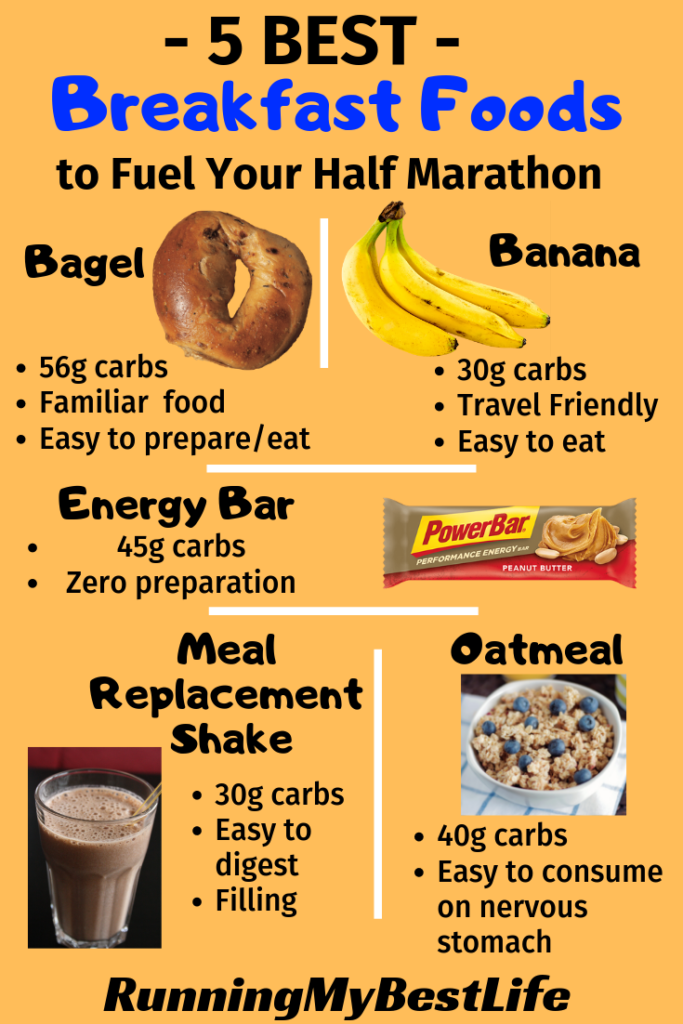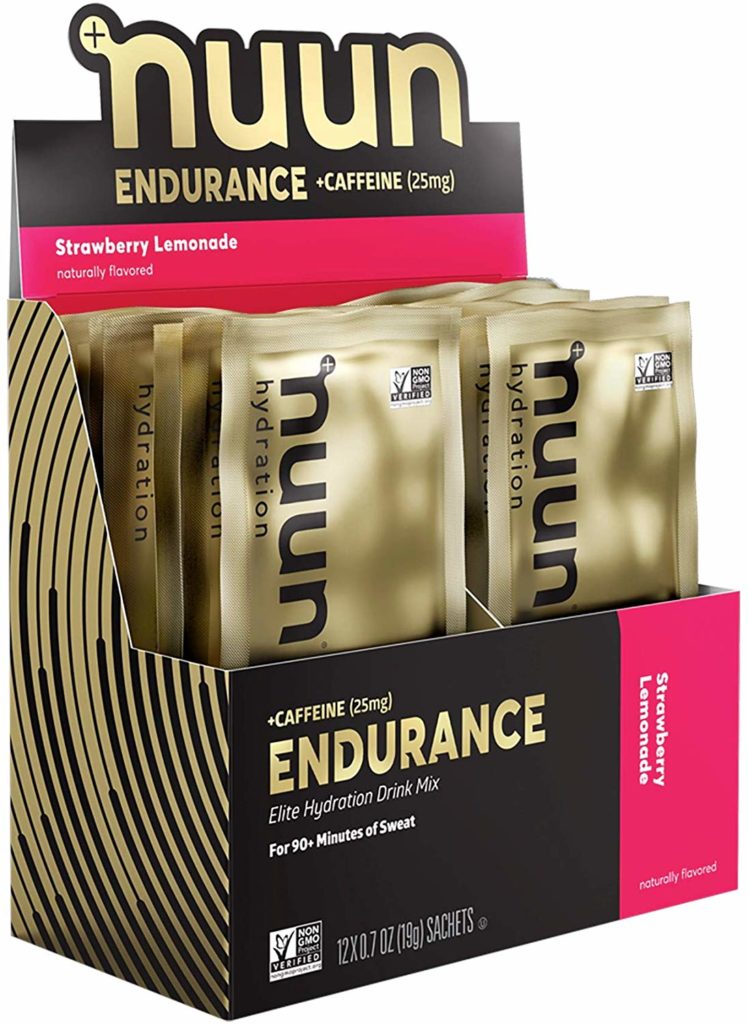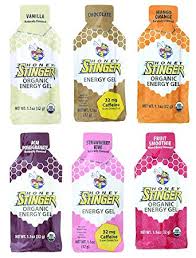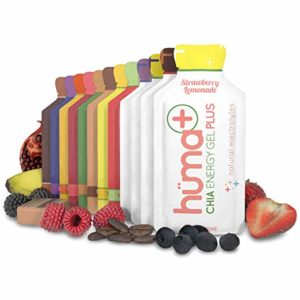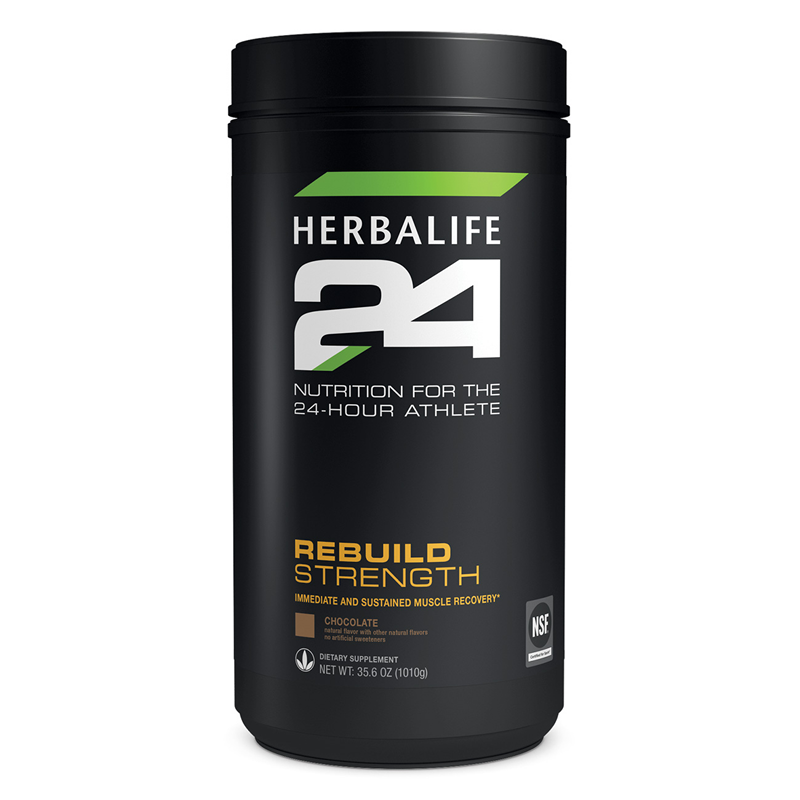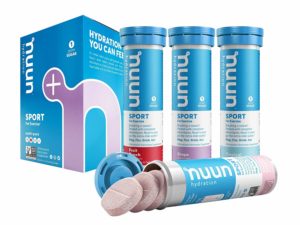Whether you’re running your first half marathon or your tenth, how to fuel a half marathon for your best performance tends to be an art, guided by the latest science.
The half marathon distance is long enough that nearly all runners need to bring some extra fuel with them to help propel them through the rigorous 13.1 miles of running!
This race day nutrition guide is designed to help you learn what the best tips and strategies are to fuel your half marathon—before, during, AND after.
I’ll cover how to select your meal the night before your race, some great breakfast ideas for the morning of your half marathon, what fuel to use and how much to consume during your race, and how to help your body recover quickly afterwards using quality nutrition to rebuild your damaged muscles.
[convertkit form=964110]
How to Fuel a Half Marathon: Your Nutritional Timeline
After following healthy eating practices throughout training to support your hard workouts and help your body recover, race day nutrition really starts with dinner the night before your race.
- Night before: Healthy, Balanced, Carbohydrate-Rich Dinner. Hydrate.
- 2-4 hours before start: Carbohydrate-Centered, Easy to Digest Breakfast. Hydrate.
- 1 hour before start: Stop hydrating so you don’t have to pee during the race!
- 5-15 minutes before start: Top off your carbohydrate levels with a gel right before the race, and wash down with a few swallows of sports drink or water.
- During the race: Drink to thirst. Aim to consume 30-60g of carbohydrate per hour.
- After you cross the finish line: Hydrate. Consume a post-run recovery shake within 30 minutes.
- The rest of the day: Keep hydrating! Plus enjoy a delicious celebration meal 🙂
What to Eat the Night Before a Half Marathon
The night before a half marathon, you want to be very conscious of your food choices. “Carb loading” is NOT your free ticket to stuff yourself full of pasta and pizza and all the delicious carbohydrate goodies that you might normally pass up.
Have you ever eaten a huge meal, and the next morning you STILL felt full and even a little lethargic from it?
Yeah, it’s a nasty feeling, and we definitely want to avoid that. If you eat too much the night before, you risk leaving yourself feeling bloated and gross on race morning. The key is to fuel your half marathon, not bog it down!
We want to feel strong, fueled, lean, and fast on race morning!
Half Marathon Dinner Ideas
Here are a few of my go-to, simple choices for dinner the night before a half marathon.
- Grilled Chicken, Roasted Red Potatoes (or Sweet Potatoes), and Veggies
- Spaghetti
- Homemade Chicken Fajitas with a Side of Brown Rice
- Grilled Hamburgers with Homemade Baked Sweet Potato Fries
When in doubt, keep it simple. You want some lean protein, an ample amount of quality carbohydrates, and a vegetable. But mostly, you want an ample amount of easily digestible carbohydrates.
The one thing you really DON’T want to eat a large amount of the night before your half marathon is fat, because that could stick around in your stomach longer than you want, and leave you feeling bloated the next morning.
Although carb-loading would be a great excuse for me to eat one of my favorite foods—fettuccine alfredo—I don’t, because I’ve learned that the high fat content in the sauce leaves me feeling heavy and bloated rather than lean and light the next morning.
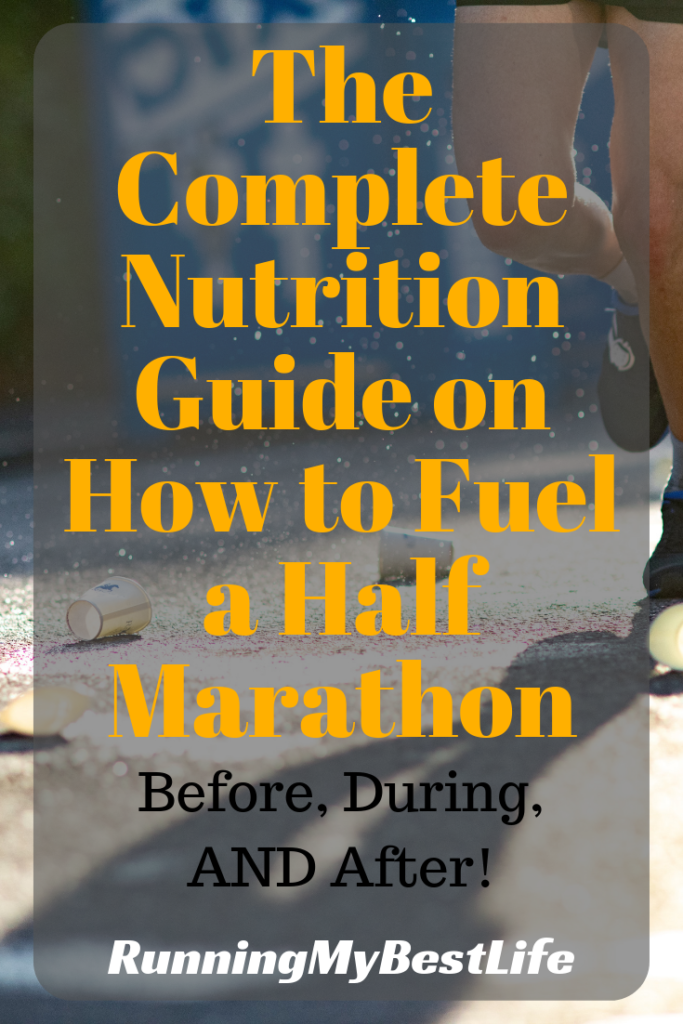
What to Eat for Breakfast the Morning of Your Half Marathon
After sleeping all night, your body’s carbohydrate (glycogen) stores in your muscles will be partially depleted. The purpose of your race morning breakfast is to top off those stores. To fuel your best half marathon, the key is to get a high carbohydrate breakfast that both digests easily and is convenient for wherever you are on race morning.
Eat your race morning breakfast around 2-4 hours before the race to allow yourself time to fully digest your breakfast. This will help you avoid the risk of upsetting your stomach during the race.
You should also make sure you hydrate on race morning. Drink 12-16 ounces of water, juice, or sports drink with your breakfast.
As a guideline, you want to consume between 1-4 grams of carbohydrate per kilogram of body weight. The actual amount really depends on how much your stomach can tolerate.
Make sure you consume at LEAST 1 g of carbohydrate per kilogram of body weight. For a 150-pound runner, this would be 68g of carbohydrate, just during breakfast!
Here are some half marathon breakfast ideas:
- Bagel with cream cheese and jam or peanut butter and honey
- Banana
- High-carbohydrate energy bar
- Meal Replacement Drink
- Oatmeal
Or, you can combine 2 of these! My go-to pre-run breakfast is a bowl of oatmeal with peanut butter and Nutella mixed in, plus a sliced banana.
How to Fuel a Half Marathon During the Race
Now it’s time for the fun stuff—race fueling!
Your muscles contain enough glycogen to keep you running for just over an hour before they run out of gas. If you’re an elite runner and can run a half marathon in an hour, then you might not need to fuel during your race. For the rest of us mortals, we’re going to need some quality carbohydrates to keep our muscles moving forward for the full 13.1 miles!
How do we figure out what we need to put in our bodies during the race?
Here are some important guidelines for race fueling:
- Consume AT LEAST 30 grams of carbohydrate per hour to see the benefits
- 60-90 grams of carbohydrate per hour can be beneficial in longer races
- 60 grams per hour is a good target
- The average gel contains around 25 grams of carbohydrate
- The average amount of sports drink given out at aid stations is 4 ounces
While shooting for these fueling targets, it’s important to note that you will need to experiment and see how much your stomach can tolerate. These numbers come from the book “The New Rules of Marathon and Half Marathon Nutrition” by training coach and certified sports nutritionist Matt Fitzgerald. He notes that 60 grams per hour is a very beneficial target for most runners, although he admits:
“Many runners cannot stomach 60 grams of carbs per hour.”
The New Rules of Marathon and Half Marathon Nutrition by Matt Fitzgerald
Basically, you will perform your best if you consume as much as your stomach can tolerate during races.
How to Design Your Half Marathon Fueling Strategy
There are 3 basic strategy options for planning your half marathon race nutrition:
1. Sports Drink + Gels + Water
This is the most preferable option, because it allows you the most effective mix of nutrition.
Use the average number of 4 ounces of sports drink per aid station to calculate how many grams of carbs you are likely to get from the official sports drink at aid stations during the race. (Or you can carry your own sports drink)
I usually carry my own sports drink, but for my next race I am going to try relying on the aid stations. Let’s walk through how I calculated my carbohydrate intake.
Multiply 4 ounces by the number of carbs per ounce (Gatorade is around 1.7 g of carbs per ounce) times how many aid stations will have sports drink to figure out how many grams of carbs you will get.
Example:
For my next race, 5 of the 6 total aid stations will be giving out electrolytes (in this case, Gatorade).
4 ounces per aid station x 5 aid stations = 20 ounces of sports drink
20 ounces of Gatorade x 1.7g carbohydrate per ounce = 34 grams of carbohydrate during the race.
If my race lasts 2 hours, that’s not enough carbs! It’s only half of the recommended 30g per hour minimum.
To get closer to my target of 60g of carbs per hour, I need to supplement with gels.
If the average gel contains 25g of carbs, I can supplement with 3 gels during the race to reach a total number of 54g of carbs per hour.
Here’s the math:
34 g carbs from sports drink + (3 gels x 25g each) = 109 grams of carbohydrate
109 grams of carbohydrate total / 2 hours on course = 54 grams per hour
Pretty simple right? All of the sudden, elementary math seems more interesting! 😉
Now wait…there is one issue. Only 2 aid stations on the course give out gels (Mile 5 and Mile 10)!!
How do I get my 3rd gel?
Simple, I’m going to bring it with me, and take it a couple minutes before the race begins.
**Race Fueling Hack**
If your stomach is sensitive to gels when you’re running, you might be able to stomach one right before the race begins, while your stomach is at rest.

2. Gels + Water
If you don’t have the luxury of choosing the sports drink provided at aid stations (aka pretty much every non-elite runner), AND your stomach doesn’t agree with the official race drink (make sure you test it out beforehand!), then you can rely on carrying gels that work for you and hydrate with plain water at the aid stations.
The math for this one is quite a bit easier. Simply figure out how many grams of carbs you need during the race based on how long you plan to be on the course, then divide that by the number of carbohydrates in each gel.
Example:
2 hours on course x 60 grams per hour = 120 grams of carbohydrate goal
120g carbs / 25g per gel = 4.8 gels (Then round up or down, depending on how often your stomach can tolerate gels.)
3. Sports Drink Only
If your stomach just doesn’t agree with gels or other fueling options, then you can use the sports drink only option. This one works if the official provided race drink is acceptable to your stomach.
Also, it’s nice because it removes the need to carry anything with you during the race. However, keep in mind that you might need to consume 2 cups of sports drink at each aid station to get above the minimum recommended carbohydrate intake and see benefits from this fueling method.

How to Fuel Your Half Marathon with the Best Products
If you’re new to running nutrition and specifically, fueling races…this part can be extremely overwhelming! There is a RIDICULOUS number of different running nutrition products out there, and it can be super confusing trying to figure out where to start. Not to mention…really expensive if you start off with products that don’t agree with your stomach and have to throw something out!
How do you sort through everything and find something that works for you?
Start by trying products that work for other people, and test out different ones to find what works for YOU. I recommend buying sample sizes whenever possible, so you don’t have a whole bunch of product on your hands if it doesn’t work for you.
Here are some of the products I personally use and feel comfortable recommending them to you! If I don’t use the product, I won’t recommend it. Test some different products out to see what works!
Sports Drink
When I’m looking for a high-calorie sports drink to provide lasting energy and carbs during a long run or race, I reach for Nuun Endurance. It’s a great option to keep your energy up and help you power through your long runs!
Energy Gels/Chews
I’ve tested out a few different gels, and I have a few that I like. It’s nice to have a few different options so I can change them up depending on what I’m feeling for that day.
One gel I love is Honey Stinger. There are a bunch of different flavors, they’re pretty easy on the stomach, and they taste great. Just make sure you love honey, because these things give you a strong shot of honey!
Click here for the Honey Stinger Sample Pack
Another gel that is really easy on my stomach is Huma Chia Energy Gels. The packages are slightly larger than most, so keep that in mind if you need to slip them in a pocket. The fruity flavors are subtle and sit easy in my stomach.
Click Here for the Huma Chia Energy Sample Pack
Most recently, I’ve tested out Honey Stinger Chews. They come in some fun flavors like cherry blossom, pink lemonade, pomegranate passion fruit, and more! Each package contains 12 chews and a total of 160 calories (39g carbs). The smaller format is really nice if your stomach needs to space out the inflow of fuel and can’t do an entire gel at once. With the chews, you can take 1-2 every 20 minutes instead of 1 gel every 30-45 minutes.
Click Here for the Honey Stinger Sample Pack
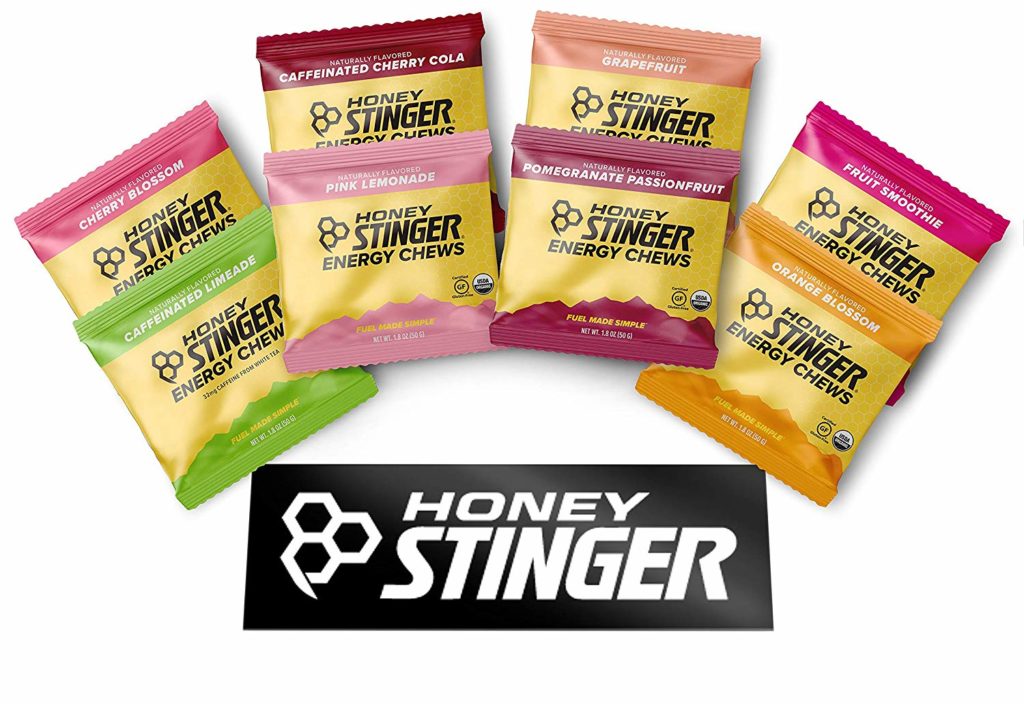
[convertkit form=876847]
How to Fuel Your Half Marathon Recovery
Woohoo! You’ve crossed the finish line, time for beer and pizza!
Not so fast…
Before you get all pumped up for your post-race meal, be sure you get some nutrition in you that will help fuel your muscle recovery, so you don’t feel like you got hit by a truck the next day.
Post-race nutrition has two main components:
1. Recovery carbohydrates and protein
Have you heard of the post-workout recovery window? Studies show that our bodies begin the recovery process within 30 minutes of completing a tough workout, so it’s important to get some good building blocks into your body and readily available so you can start healing your muscles after finishing your half marathon.
The ideal window is within 30 minutes, so let yourself cool down, hydrate, and catch your breath. Then be sure to get a recovery shake in your belly!
The other reason I like to do a recovery shake right away is so the ravenous hunger [read: HANGER] doesn’t hit me in that hour following the race. If I get a shake down in the first 30 minutes, then I have time to enjoy the post-race goodies, shower, and find a real meal [read: celebration meal] 2-3 hours later.
The best recovery shake for right after a half marathon is Herbalife24 Rebuild Strength. Designed specifically for athletes, the carbohydrate blend supports the delivery of amino acids for muscle synthesis to help enhance muscle recovery. At 190 calories, it has just enough to help you avoid the “hangry” feeling and start the recovery process.
Click Here for Herbalife24 Rebuild Strength
Another option for right after the race if you don’t have a shaker cup to mix up a shake is the Honey Stinger Energy bars. They have similar nutritional content, and you can throw one in your gear check bag (link) for right after the race.
Click Here for Honey Stinger Protein Bars

2. Hydration
No matter how well you follow your race nutrition and fueling plan, you are still going to be pretty dehydrated after you finish your race.
In addition to getting some recovery carbohydrates and protein in your body, hydration is also imperative for muscle recovery and preventing cramps.
My absolute favorite product for every day, all day hydration is Nuun! I usually drink 1-2 of these per day (3+ on long run or race days) and at only 10 calories per tablet, they really aren’t affecting my calorie intake. They taste delicious and have several variations for sport, with caffeine, immunity, extra vitamins, and rest. The come in small tubes with 10 tablets in each, so they’re super portable! The tubes make these especially easy to take with for hydration when you travel, going through airports or on the road.
Nuun Rest is also a great option for post-race hydration and recovery.
How to Dial-In Your Half Marathon Nutrition
As you get ready for your half marathon, I recommend breaking down each element of your fueling plan and testing different things to see what works for you.
The major elements of half marathon nutrition are:
- Dinner the night before your race
- Breakfast on race morning
- Fueling During the Race
- Refueling, Recovery, and Hydration after the race.
What are your favorite race day fueling rituals?
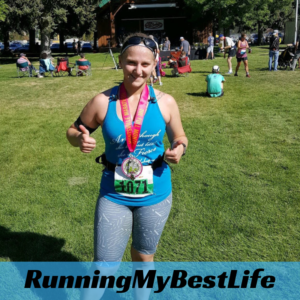
Run Happy,
Alexis
- Nailing Your Marathon Hydration Strategy: A Comprehensive Guide
- Conquering Marathons in the Cold: A Comprehensive Guide
- Harnessing the Power of Technology for Successful Marathon Training
- Mastering the Marathon: The Ultimate Guide to Nutrition and Training
- Ultimate Guide to the Top 5 Running Shoes for Beginners in 2023
About Me: I’m Alexis, Founder of RunningMyBestLife! I am an avid recreational runner, half marathoner, wife, dog mom, busy professional, downhill skier in Northern Utah. My mission is to help new enthusiasts fall in love with the sport of running. I believe that running is a catalyst to taking control of your life and living your best life by design. Learn More –>
